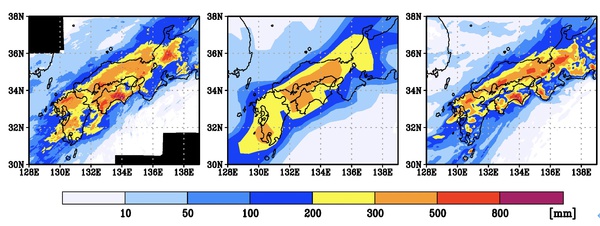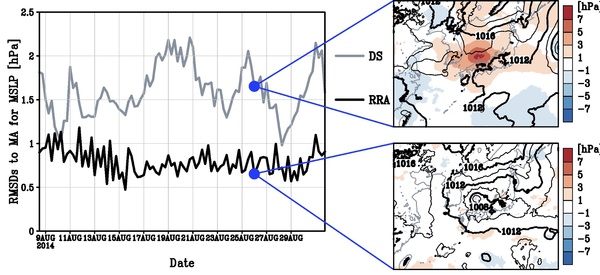Topics 2021.09.14
Estimating the past atmosphere
Figure 1 Accumulated precipitations in 5-7 July 2018. The left is an observation (the Japan Meterological Agency's radar/raingauge observation). The middle is an existing global reanalysis (the Japanese 55-year Reanalysis), which is equivelent to grid spacing of about 50 km. The right is the regional reanlysis with 5-km grid spacing.
Atmospheric Science Laboratory works on studies to estimate the past three-dimensional atmosphere over Japan, "regional reanalysis". Here, reanalyses are to reproduce the past atmospheric fields with observations obtained by measuring the actual atmosphere and numerical models based on the physical laws governing meteorological phenomena. The reanalyses have been conducted by major numerical weather prediction centers in the world, contributing to various kinds of purposes. However, these reanalyses, which cover the global, are too course to resolve the mesoscale phenomena and fine topography effects.
To overcome the limitation, we have developed a regional reanalysis system with grid spacing of 5 km, limiting the domain to Japan and its surrounding area (Fukui et al., 2018). Our study has revealed advantages of our regional reanalysis in terms of resolution. Figure 1 shows the accumulated precipitation in 5-8 July 2018. Our 5-km grid regional reanalysis successfully simulate the heavy rainfall event, including detailed spatial distributions. In contrast, while an existing reanalysis produced with a system equivalent to grid spacing of about 50 km cannot represent the detailed distributions, while it simulates heavy rainfall roughly over the western Japan.
Our regional reanalysis system is designed to extract signals of the climate change. Reanalyses are generally conducted with a fixed set of numerical model and data assimilation scheme to keep the long-term consistency in quality throughout the reanalysis periods. In our reanalysis system, as an additional setup, we limit the assimilated observations to the conventional observations, such as surface pressure observations and upper-air radiosonde observations. Here, a question arises whether assimilating the limited observations can improve the estimated atmospheric fields against the system without assimilating any observations. The left panel in Fig. 2 shows the errors of the mean sea level pressure fields estimated with systems with and without assimilating the observations. We can see, assimilating the observations, even though they are limited, successfully reduces the errors. The right panels in Fig. 2 show the snapshots as a sample. In this case, the assimilating observations contribute to accurate reproduction of a synoptic-scale depression system located near the center of the figures. Our study confirmed that one of advantages of our regional reanalysis in terms of assimilating observations.
We are conducting the regional reanalysis to cover past 60 years. We have plans to use the produced dataset to understand effects of the global warming to the local climate and to investigate past extreme events such as torrential rainfalls. It can also be used as references in disaster preventions and various industries applying information about weather and climate. To improve the reanalysis system is another important future work. We should explore methods to extract information from the limited observations to maximize the quality. To develop the numerical model is also necessary. The regional reanalysis system is based on numerical weather/climate prediction systems. The knowledges obtained in developing the system will contribute to better weather and climate prediction. The regional reanalysis has a potential to be a key to develop various research themes.
(Shin Fukui, Atmospheric Science Laboratory)
Acknowledgement:
The studies of the regional reanlysis are conducted as a joint research project between Tohoku University and Meteorological Research Institute.
Reference:
Fukui, S., T. Iwasaki, K. Saito, H. Seko, and M. Kunii, 2018: A feasibility study on the high-resolution regional reanalysis over Japan assimilating only conventional observations as an alternative to the dynamical downscaling. J. Meteor. Soc. Japan, 96, 565-585. DOI:10.2151/jmsj.2018-056.
Figure 2 Errors of mean sea level pressure fields. The left is time series of the errors of regional reanalysis system (black line) and the same system but without assimilating observations (gray line). The right are sample fields of the mean sea level pressures (contours) and its errors (shades). The lower and upper are the regional reanalysis and the same system but without assimilating observations, respectively.


